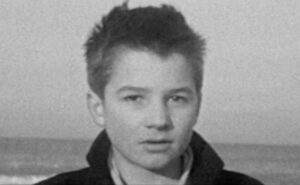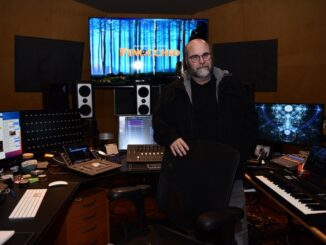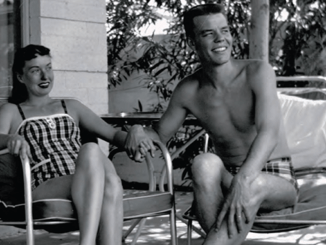
by Kevin Lewis
In 1959, the Nouvelle Vague, or New Wave, revolutionized the concept of film editing and scene construction in international film. Though its effects were not implemented in American cinema until the late 1960s, serious American moviegoers––bored with bland American films, which became wider but not deeper––discussed these New Wave films as they would literature. The irony is that the Cahiers du Cinema journalists-cum-directors/writers/editors––such as Jean-Luc Godard, Eric Rohmer, Claude Chabrol, Jacques Rivette and François Truffaut (and the Nouvelle Roman writer Alain Resnais)––emulated American film classics by such directors as Howard Hawks, Nicholas Ray, John Ford, Buster Keaton and Charles Chaplin, among others, as well as the films of such pioneering French directors as Jean Vigo, Abel Gance, Louis Feuillade and Jean Renoir.
Truffaut, who admired Ray, wrote and directed Les Quatre Cents Coups (The 400 Blows), released 50 years ago in May 1959. Though it explores the same theme as Ray’s Rebel Without a Cause (1955)––adolescent rebellion and frustration––Les Quatre Cents Coups is an original, unique movie with a 14-year-old boy, close in style to Vigo’s Zero for Conduct (1933). The 400 Blows is a literal translation of a French idiomatic phrase about sowing one’s wild oats, or raising hell, while young. Jean-Pierre Léaud, the 14- year-old that Truffaut found to play the part of Antoine Doinel, became the filmmaker’s doppelganger.
For the next 20 years, Truffaut made four features and one short chronicling the life of Doinel as played by Léaud. The others were the episode Antoine and Colette from L’Amoura Vingt And (Love at Twenty, 1962), Baisers Volés (Stolen Kisses, 1968), Domicile Conjugal (Bed and Board, 1970) and L’Amour en Fuite (Love on the Run, 1979).
The film is autobiographical. Truffaut, a lost child himself like Doinel, was saved from jail by his surrogate father: film critic and theorist André Bazin, who co-founded Cahiers du Cinema in 1951. Truffaut, who was rejected by his unwed mother and raised by his maternal grand- mother until her death when he was very young, grew up in the cinemas of Nazi- occupied France because life at home with his resentful mother and stepfather was miserable. He met Bazin through his activity in cinema clubs.
Bazin admired the deep-focus cinematography of Gregg Toland in films by William Wyler and Orson Welles, the wide shots and proto-neorealism in Renoir’s films, the long takes in the films of Alfred Hitchcock, and the overlapping dialogue in Hawks films. Bazin sought “objective reality” in feature films, traditionally associated with documentaries and Italian neorealism film. The hand-held camera, which was previously used only in documentaries for practical and logistical reasons, aided in the creation of realism in feature films because the unsteady nature of the footage made studio films look fake by comparison. The critic crystallized what he saw as an authorship by directors, which became his concept of “personalism.” His Cahiers journalists expanded this into the auteur theory, which American film critic Andrew Sarris wrote about in his columns in New York.
Truffaut’s 1954 Cahiers du Cinema essay, “A Certain Tendency In French Films,” rocked the French film industry because he called French films “the cinema of Papa.” French cinema in the main was uncritical of the right-wing French government in the 1950s, and ignored the twin disasters of Vietnam and Algeria, as well as the strikes, poverty and progressive politics which polarized French life and classes in General-cum-President DeGaulle’s France. It is interesting that American film embraced the New Wave only when the United States was polarized over Vietnam, labor strikes, racial conflict and poverty in the late 1960s. Even more curiously, the film that introduced New Wave techniques into American cinema was Bonnie and Clyde (1967), which writers David Newman and Robert Benton originally sent first to Truffaut and then to Godard to direct, before Arthur Penn eventually was signed. Dede Allen, A.C.E., who edited the film with complete support from Penn, was one of the earliest American editors to espouse New Wave editing.
Because Truffaut the essayist was met by French film critics and the industry with a “Can you do better?” challenge, he raised money and made the short film Les Mistons in 1957. The success of that pre- New Wave film encouraged him to make Les Quatre Cents Coups, for which he won the Best Director Award at the 1959 Cannes Film Festival––an ironic turn of events because Truffaut’s anti-French film industry stance caused him to be banned from the festival the previous year. Truffaut used his profits to finance Godard’s 1960 breakthrough film, A Bout de Souffle (Breathless). Soon, the indus- try was filled with New Wave directors, different in their approaches but always innovative in their editing and direction.
For Sarris, the artistic link between Truffaut and Renoir was so strong––both visually and personally––that the former agreed to contractually complete the last films of Renoir if the septuagenarian was unable to do so himself. Truffaut was influenced by the humanism of Renoir, according to Sarris, but “the intermediary in both cases was André Bazin.” It can be argued that Bazin “created” Truffaut, molded his artistic choices, his humanistic philosophy and his technique. The legendary American film critic also points out that Bazin developed the unified visual field concept––the figure in continuous relationship with the landscape––which Truffaut used in Les Quatre Cents Coups’ concluding race across the French landscape, and which Renoir had previously incorporated in the escape by the prisoners of war in Le Grande Illusion (1937). Truffaut, like Renoir, did not utilize montage as an editorial solution; Godard was the New Wave director famous for jump cuts.

The last shot of Les Quatre Cents Coups (Doinel running as far as he can to escape, realizing he has run out of options as well as space, and staring into the camera with a resigned but confrontational stare) was vastly imitated by other filmmakers because it was an innovative freeze frame.
Truffaut took credit for the freeze frame, but film critic and historian Elliott Stein, who lived in Paris at the time and worked in the film industry, heard from many in French cinema that it was really a solution devised by his editor, Marie-Josèphe Yoyotte, along with assistant editors Cécile Decugis and Michèle de Possel. According to Stein, Truffaut “did not know much about editing and gave her no coverage” for the scene, so she just froze the image, which was a visual reminder of Doinel’s mug shot in the police station seen earlier. Truffaut liked it, and it was a happy accident––just the spontaneity needed to spark a revolution in film language. Freeze frame had been used for many years in other films, but this was a new meaning to the British phrase for a finish: “a full stop.”
Interestingly, Decugis was the original editor for Truffaut on Les Mistons, as well as the editor for Godard on A Bout de Souffle, but her career was curtailed for much of the 1960s because she was imprisoned for assisting in the underground for Algerian independence fighters. “No one helped her,” says her colleague and friend, director and editor Jackie Raynal. After her release around 1967, Decugis primarily edited the great films of Eric Rohmer, among them, Ma Nuit Chez Maud (My Night at Maud’s, 1969), Genou de Claire (Claire’s Knee, 1970), L’Amour l’apres-midi (Chloe at the Beach, 1972), and Le Beau Mariage (1982), but never again for Truffaut or Godard.
In March 2009, the Criterion Collection released a deluxe edition of The 400 Blows in the high-definition Blu-ray for- mat, which brings those figures and landscapes onto an almost three-dimensional plane. The famed 360-degree scene, in which Doinel spins around at rapid speed in the carnival centrifuge, is now truly exhilarating, and even the final freeze frame of Doinel is especially challenging. Included in the edition are such extras as footage of Léaud at the Cannes Film Festival, his audition for the role, a television interview with Truffaut about the relationship between the director and his character, an essay by scholar Annette Insdorf and commentaries by cinema professor Brian Stonehill and Truffaut’s lifelong friend and the film’s production manager Robert Lachenay.
Part Two of this article will examine Renoir’s Le Régledu Jeu (The Rules of the Game, 1939)––a direct influence on the New Wave––on its 70th anniversary. It will appear in the JUL-AUG 09 issue of Editors Guild Magazine.





